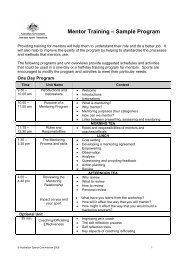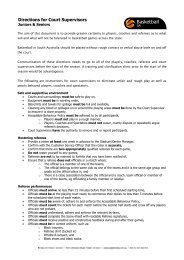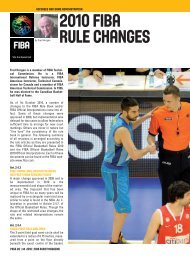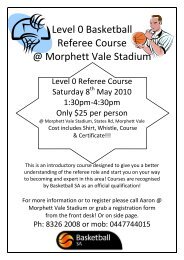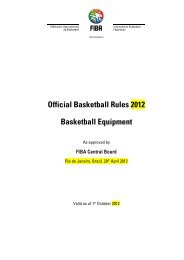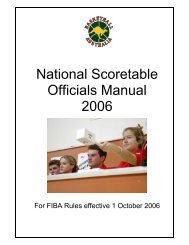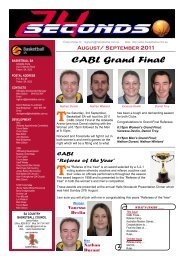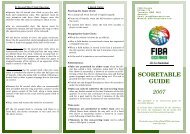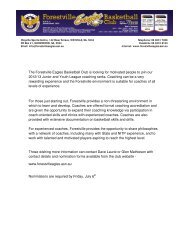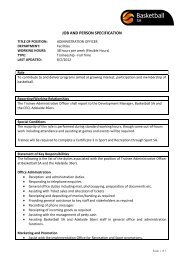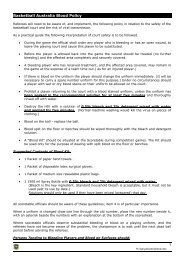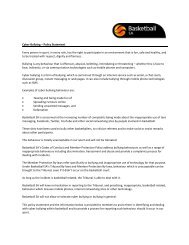COMMENTS ON UNSPORTSMANLIKE FOUL - Basketball SA
COMMENTS ON UNSPORTSMANLIKE FOUL - Basketball SA
COMMENTS ON UNSPORTSMANLIKE FOUL - Basketball SA
Create successful ePaper yourself
Turn your PDF publications into a flip-book with our unique Google optimized e-Paper software.
REFEREES, SCORER’S TABLE AND COMMISSI<strong>ON</strong>ERS<br />
by Alberto Garcia<br />
<strong>COMMENTS</strong> <strong>ON</strong><br />
<strong>UNSPORTSMANLIKE</strong><br />
<strong>FOUL</strong><br />
Alberto Garcia is a former FIBA international<br />
referee and FIBA Referee<br />
Instructor. He is now Sub-Secretary<br />
General of FIBA Americas.<br />
For a number of years, the game of basketball<br />
has recognized various problems<br />
regarding the tactics of coaches, the<br />
actions of players, and the different<br />
guidelines used by the referees in the<br />
application of the concept of the<br />
unsportsmanlike foul. For this reason, the<br />
World Technical Commission has seen<br />
the need to make changes to this rule and<br />
to the interpretational guidelines that<br />
underline the spirit of fair play. Through<br />
FIBA's International Instructors, these<br />
changes were communicated to National<br />
Instructors and to the referees of the<br />
world.<br />
An example of this philosophy of play is<br />
the limiting of the number of unsportsmanlike<br />
fouls that players may commit in<br />
a game. In doing so, the Technical<br />
Commission was attempting to develop a<br />
rule that would eliminate violent actions<br />
and rough play and to distinguish<br />
between a normal personal foul and an<br />
unsportsmanlike foul. This was also<br />
based on the principle that basketball is a<br />
non-contact sport and that the game<br />
requires the least number of interruptions<br />
possible to maintain its beauty, intensity,<br />
and fundamentals without any type of<br />
physical violence.<br />
The topic of these comments, however, is<br />
not the specific wording of Article 36. The<br />
wording leaves one with little doubt as to<br />
its real objectives. Instead, it is about the<br />
need for the rule to be properly communicated<br />
by the instructors and interpreted<br />
by referees. Even more important is that it<br />
be uniformly applied in game situations.<br />
Because it is a concept where the guidelines<br />
used by the referees are of fundamental<br />
importance if the rule is to be<br />
applied properly and consistently, FIBA<br />
attempted, though the instructors of the<br />
world, to make clear what is the differ-<br />
FIBA ASSIST MAGAZINE | 18 2006 | PAGE 43
REFEREES, SCORER’S TABLE AND COMMISSI<strong>ON</strong>ERS<br />
ence between a normal personal foul and<br />
an unsportsmanlike foul. Despite this, the<br />
situation remains unresolved and problems<br />
of unsportsmanlike tactics during<br />
the last few minutes of a game continue.<br />
In special moments of the game with a<br />
close score and a situation of high tension<br />
felt by the players, the referees might<br />
feel pressured in some way to call fouls<br />
that could influence the final result of the<br />
game. However, the main problem is not<br />
so much what is happening at the end of<br />
a game, but rather what has happened<br />
during the game up to that point. Many<br />
referees do not apply the unsportsmanlike<br />
foul correctly when situations arise in<br />
the first half, and this is primarily where<br />
the problem lies.<br />
Previously, when what is now an<br />
"unsportsmanlike" foul was called an<br />
"intentional" foul, by its own name it<br />
brought different interpretations and consequently<br />
different criteria to apply, creating<br />
confusion for everybody, including<br />
spectators. It should be understood that<br />
many fouls are committed intentionally by<br />
using different tactics or in strategic situations<br />
with the intention of trying to win<br />
the game, causing with it the stopping of<br />
the game clock, and the sending of a player<br />
to the free-throw line instead of permitting<br />
possible shots for two- or three-point<br />
field goals. Such fouls can be intentional,<br />
but not necessarily unsportsmanlike.<br />
What this comparison really shows is that<br />
the simple commission of a foul is not the<br />
problem; the problem is with the tactics<br />
used by coaches and players, tactics not<br />
interpreted in the proper context by the<br />
referees based on the spirit of the game<br />
as applied to the official rules.<br />
Article 36.1.4 clearly states the principal<br />
considerations for judging an unsportsmanlike<br />
foul. These are:<br />
1. If a player makes NO effort to PLAY<br />
THE BALL and contact occurs, it is an<br />
unsportsmanlike foul.<br />
2. If a player, in an effort to play the ball,<br />
causes EXCESSIVE C<strong>ON</strong>TACT (hard<br />
foul), then the contact shall be judged<br />
to be unsportsmanlike.<br />
3. If a play that is not normal to basketball<br />
causes a player to establish contact<br />
with an opponent, it is an<br />
unsportsmanlike foul.<br />
Based on what is written in the rule and<br />
its respective interpretation, it should be<br />
perfectly clear when what could have<br />
been a normal foul ceases to be "normal"<br />
PAGE 44 | 18 2006 | FIBA ASSIST MAGAZINE
and becomes "unsportsmanlike" and must<br />
be sanctioned as such.<br />
There are common examples that the referee<br />
instructors use in relation to the<br />
above-mentioned principles and which<br />
can be used to clarify the three statements<br />
made above.<br />
1. Each time a player is not trying to play<br />
the ball and makes contact with an<br />
opponent, this must be considered an<br />
unsportsmanlike foul and be sanctioned<br />
immediately, especially in the<br />
last seconds of a game and when the<br />
foul is NOT a normal foul.<br />
2. Players know that an attempt to block<br />
a shot or prevent a move to the basket<br />
must not involve contact with an<br />
opponent; if contact does occur, a<br />
normal personal foul will result. If,<br />
however, the player uses excessively<br />
rough contact, this must be taken into<br />
consideration and an unsportsmanlike<br />
foul be charged immediately.<br />
3. When we talk about "normal play" in<br />
basketball, we have to know the rules<br />
and, in addition, the spirit of the rules.<br />
Moreover, we also have to understand<br />
the game itself. We must understand<br />
that grasping a player's shirt<br />
can be a normal personal foul or can<br />
be unsportsmanlike when, for example,<br />
there is a large space between<br />
the two opponents. There are other<br />
examples as well: during a throw-in,<br />
an in-bounds player pushes an opponent<br />
in order to make a space to<br />
receive the ball; during post play, the<br />
defensive or offensive player uses his<br />
knee to prevent the opponent from<br />
maintaining his position or from moving<br />
to another place on the floor.<br />
These comments will hopefully serve to<br />
help all involved in basketball-especially<br />
referees-understand the importance they<br />
have in the dynamics and purity of the<br />
game. It is the responsibility of the referees<br />
and, through them, the players to<br />
understand and accept the criteria for the<br />
unsportsmanlike foul and apply the rule<br />
correctly and consistently. Good referees<br />
"never fear to sanction an unsportsmanlike<br />
foul; evaluate the action and do not<br />
think about the penalty."<br />
A final personal thought: It is preferable to<br />
be mistaken in sanctioning a normal personal<br />
foul as an unsportsmanlike foul<br />
rather than mistaken by sanctioning an<br />
unsportsmanlike foul as a normal personal<br />
foul.<br />
FIBA ASSIST MAGAZINE | 18 2006 | PAGE 45



